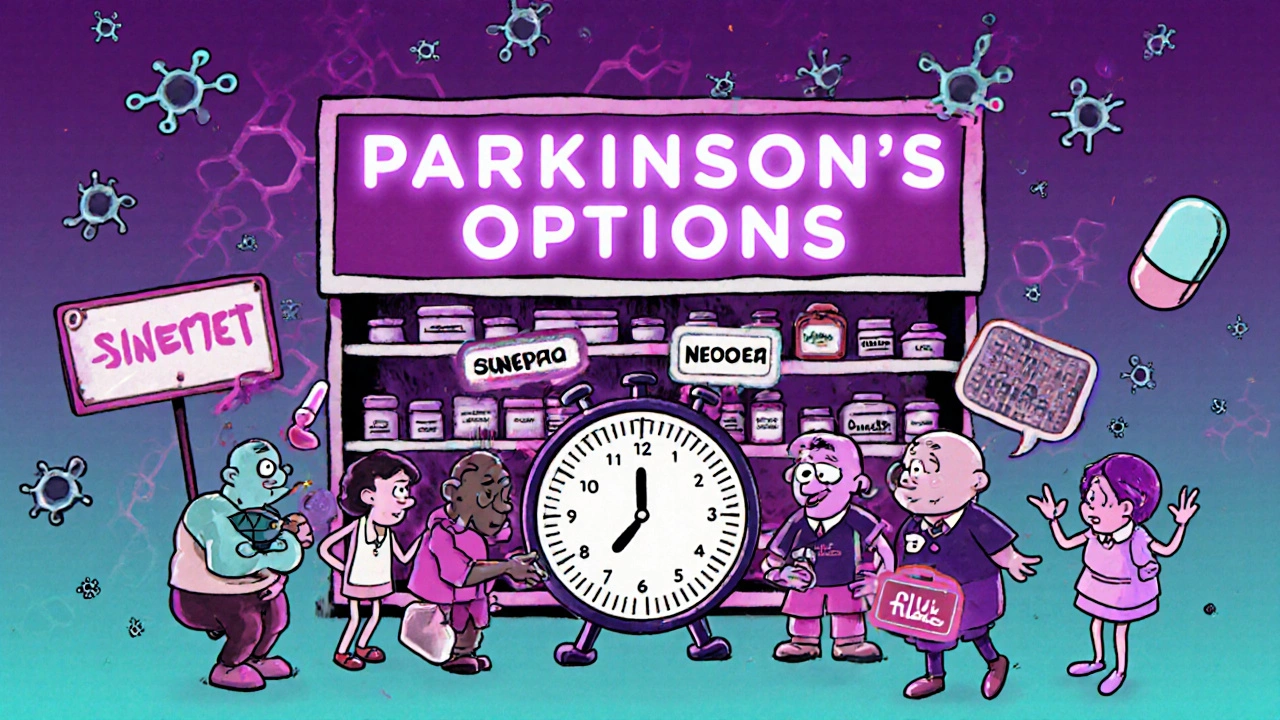Parkinson's Medication Guide
Find Your Best Parkinson's Treatment Option
Answer a few questions about your symptoms and needs to identify medications that might work best for you.
What are your primary symptoms?
When you’re managing Parkinson’s disease, finding the right medication isn’t just about symptoms-it’s about quality of life. Sinemet, which combines carbidopa and levodopa, has been the gold standard for decades. But it’s not the only option anymore. Many people on Sinemet face side effects like nausea, dizziness, or sudden movement changes called "on-off" fluctuations. If you’re wondering whether there’s something better, easier, or more stable, you’re not alone. Let’s look at what else is out there, what works differently, and who might benefit from switching.
How Sinemet Works-and Why It’s Still Common
Sinemet is a combination pill: levodopa is the active ingredient that becomes dopamine in the brain, and carbidopa prevents levodopa from breaking down before it reaches the brain. This combo means more levodopa gets where it’s needed, with fewer side effects than levodopa alone. It’s effective for tremors, stiffness, and slow movement. Most people feel better within 20 to 60 minutes after taking it.
But here’s the catch: over time, the brain gets less responsive. Doses need to be taken more often. The effects don’t last as long. Some people experience sudden shifts from being able to move freely to being frozen in place-called "off" periods. Others get uncontrolled movements during "on" periods. These fluctuations make daily life unpredictable.
Madopar: The European Alternative
Madopar is the European version of Sinemet, but it uses a different salt form: levodopa with benserazide instead of carbidopa. Both drugs work the same way-blocking the breakdown of levodopa outside the brain. The difference? Benserazide is slightly less potent than carbidopa at preventing peripheral breakdown, so you might need a higher dose of Madopar to get the same effect as Sinemet. In practice, most patients don’t notice a big difference in effectiveness. But if you’re traveling or living abroad, Madopar might be your only option.
One key point: Madopar comes in immediate-release and controlled-release forms. The controlled-release version helps smooth out the "on-off" swings for some people, but studies show it doesn’t work as well for everyone. It also takes longer to kick in, so it’s not ideal if you need fast relief during a sudden "off" episode.
Duopa: The Infusion Option
If you’ve been on Sinemet for years and your symptoms are getting harder to control, Duopa might be the next step. It’s not a pill-it’s a gel. Duopa delivers carbidopa and levodopa directly into the small intestine through a pump connected to a tube. This bypasses the stomach, where absorption can be inconsistent.
It’s designed for people with advanced Parkinson’s who have severe motor fluctuations. Clinical trials showed patients on Duopa spent 2.5 fewer hours per day in the "off" state compared to oral levodopa. That’s a big deal when you’re trying to cook, walk, or talk without sudden freezes.
But Duopa isn’t simple. You need surgery to place the tube. The pump must be refilled daily. There’s a risk of infection or tube blockage. It’s expensive. And it’s only approved for people who’ve already tried oral meds and still struggle. Still, for those who qualify, it can be life-changing.
Neupro Patch: Continuous Dopamine Stimulation
What if you could avoid taking pills five times a day? The Neupro patch (rotigotine) delivers dopamine agonists through your skin, 24 hours a day. Unlike levodopa, it doesn’t rely on brain cells to convert it into dopamine-it directly stimulates dopamine receptors.
This continuous delivery helps reduce "off" time and smooths out movement swings. It’s especially useful for early-stage Parkinson’s or for people who have trouble swallowing pills. Studies show it improves motor control and sleep quality better than placebo.
But it’s not perfect. Skin reactions are common-itching, redness, swelling. Some people feel dizzy or nauseous. Weight gain and impulse control issues (like gambling or overeating) can happen, too. And it’s pricey. Most insurance plans require you to try oral meds first before approving the patch.

Requip and Mirapex: Oral Dopamine Agonists
Requip (ropinirole) and Mirapex (pramipexole) are pills that act like dopamine in the brain. They’re often used in early Parkinson’s, sometimes alone, sometimes with a low dose of levodopa.
They’re good for delaying the need for levodopa, which helps avoid long-term side effects. People on dopamine agonists tend to have fewer "on-off" fluctuations early on. But they come with their own risks: sleep attacks (falling asleep without warning), hallucinations, and compulsive behaviors.
Requip and Mirapex are taken multiple times a day. Mirapex has an extended-release version that helps with nighttime symptoms and reduces dosing frequency. Both are cheaper than Duopa or Neupro, but they’re not as strong as levodopa. If your symptoms worsen, you’ll likely still need to add levodopa later.
Comtan and Tasmar: Adding a Helper to Sinemet
What if you like Sinemet but want it to last longer? That’s where COMT inhibitors come in. Comtan (entacapone) and Tasmar (tolcapone) block an enzyme that breaks down levodopa in the body. They’re taken with each Sinemet dose to extend its effect.
Comtan is safer and more commonly used. It adds about 1 hour of "on" time per dose. Tasmar is stronger but carries a risk of liver damage, so it requires monthly blood tests. Most doctors avoid Tasmar unless everything else has failed.
These aren’t replacements for Sinemet-they’re add-ons. You still need the same number of Sinemet pills, but each one works longer. If you’re taking Sinemet four times a day and still having "off" periods, adding Comtan might help without switching medications.
Amantadine: The Symptom Buffer
Amantadine was originally an antiviral drug. Then doctors noticed it helped with Parkinson’s tremors and dyskinesia-the involuntary movements that come from long-term levodopa use.
It doesn’t replace levodopa, but it can reduce the severity of dyskinesia. Many people take it alongside Sinemet to smooth out the rough edges. It’s one of the few drugs that helps with both movement and non-movement symptoms like fatigue.
Side effects include ankle swelling, livedo reticularis (a mottled skin pattern), and confusion in older adults. It’s usually well-tolerated in younger patients. A newer extended-release version, Gocovri, is approved specifically for dyskinesia and can be taken once daily at bedtime.

When to Consider Switching from Sinemet
You don’t need to switch just because you’ve been on Sinemet for years. But if you notice any of these signs, it’s time to talk to your neurologist:
- You’re taking Sinemet more than five times a day and still having "off" periods
- Your movements become unpredictable-sometimes you’re fine, other times you’re stuck
- You’re experiencing dyskinesia (uncontrolled twisting or jerking) that interferes with daily tasks
- You can’t swallow pills reliably, or your stomach empties too slowly
- You’re having hallucinations, sleep attacks, or compulsive behaviors
There’s no rush. Switching meds is a process. Your doctor will likely try adding a helper drug (like Comtan or amantadine) before moving to something entirely new. The goal isn’t to stop Sinemet-it’s to make it work better.
What Doesn’t Work (And Why)
Some people try natural supplements like CoQ10, vitamin E, or green tea extract hoping they’ll help. These haven’t been proven to slow Parkinson’s progression or replace medication. Some can even interfere with your prescription.
Also, don’t assume newer = better. Deep brain stimulation (DBS) surgery is effective for advanced cases, but it’s invasive and expensive. It’s not a replacement for medication-it’s an add-on. And while gene therapies and stem cell treatments are being studied, they’re still experimental. Stick with what’s FDA-approved unless you’re in a clinical trial.
Choosing the Right Alternative for You
There’s no one-size-fits-all. Here’s how to think about your options:
| Medication | Form | Best For | Key Limitation |
|---|---|---|---|
| Madopar | Oral pill | International patients, similar effect to Sinemet | Slower onset than Sinemet; less predictable absorption |
| Duopa | Intestinal gel + pump | Advanced Parkinson’s with severe "off" time | Surgery required; daily pump maintenance |
| Neupro Patch | Transdermal patch | Early-stage, swallowing issues, smooth symptom control | Skin reactions; risk of sleep attacks |
| Requip / Mirapex | Oral pill | Delaying levodopa use; mild symptoms | Compulsive behaviors; less effective as disease progresses |
| Comtan | Oral pill (add-on) | Extending Sinemet’s effect | Only works with levodopa; causes orange urine |
| Amantadine | Oral pill | Reducing dyskinesia | Swelling, confusion in elderly |
Ask yourself: What’s the biggest problem right now? Is it too many pills? Too many "off" times? Uncontrolled movements? Then match your goal to the option that targets it.
Final Thoughts
Sinemet isn’t going away. For most people, it’s still the most effective tool. But Parkinson’s is a moving target. What works today might need adjusting next year. The goal isn’t to find the "best" drug-it’s to find the best combination for you at this stage.
Don’t be afraid to ask your doctor: "Is there something else that might help me have more good days?" Keep track of your symptoms. Note when you feel strong, when you freeze, when you feel off. That data matters more than any drug label.
There are more options now than ever before. You don’t have to live with unpredictable symptoms. With the right plan, you can get back more control-and more of your life.
Can I switch from Sinemet to a dopamine agonist without losing symptom control?
It depends. Dopamine agonists like Requip or Mirapex are less potent than levodopa. If your Parkinson’s is advanced, switching entirely may make symptoms worse. But if you’re in the early stages, some people can start on a dopamine agonist and delay levodopa for years. Always do this under medical supervision-never stop Sinemet suddenly.
Is Duopa better than taking Sinemet multiple times a day?
For people with advanced Parkinson’s who have severe "off" time (more than 2 hours a day), Duopa is often better. It delivers levodopa steadily, reducing fluctuations. But it’s not for everyone. It requires surgery, daily pump refills, and constant monitoring. For many, adding Comtan or switching to extended-release Sinemet is simpler and just as effective.
Why does Sinemet stop working as well over time?
Parkinson’s damages dopamine-producing cells in the brain. As more cells die, the brain loses its ability to store and release dopamine smoothly. Levodopa works by replacing dopamine, but without enough storage capacity, the effects become short-lived and unpredictable. This leads to "on-off" fluctuations. It’s not that Sinemet stops working-it’s that the brain’s ability to use it declines.
Can I take Sinemet with other medications for high blood pressure or depression?
Some medications can interfere. Iron supplements, vitamin B6 (in high doses), and certain antacids can block levodopa absorption. Some antidepressants (like MAOIs) can cause dangerous interactions. Always tell your doctor about every pill, supplement, or herb you take. Even over-the-counter meds can change how Sinemet works.
Are there any new Parkinson’s drugs coming soon?
Several new drugs are in late-stage trials. One, called opicapone (Ongentys), is already approved in Europe and works like Comtan but lasts longer-just one dose per day. Another, called valbenazine, helps reduce dyskinesia. While these aren’t revolutionary, they offer more fine-tuning options. True disease-modifying treatments (that slow progression) are still years away.




Margaret Wilson
November 19, 2025 AT 17:20Will Phillips
November 20, 2025 AT 21:20Arun Mohan
November 21, 2025 AT 22:53Tyrone Luton
November 22, 2025 AT 00:05william volcoff
November 22, 2025 AT 19:32Brad Samuels
November 23, 2025 AT 16:56Mary Follero
November 24, 2025 AT 01:07darnell hunter
November 26, 2025 AT 00:17Hannah Machiorlete
November 27, 2025 AT 10:18Bette Rivas
November 28, 2025 AT 17:59prasad gali
November 30, 2025 AT 00:05Paige Basford
December 1, 2025 AT 01:33Ankita Sinha
December 1, 2025 AT 02:38Kenneth Meyer
December 2, 2025 AT 20:13